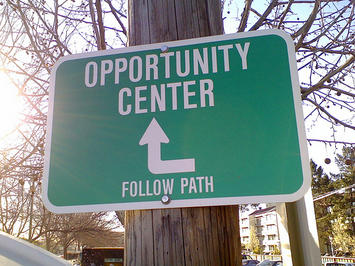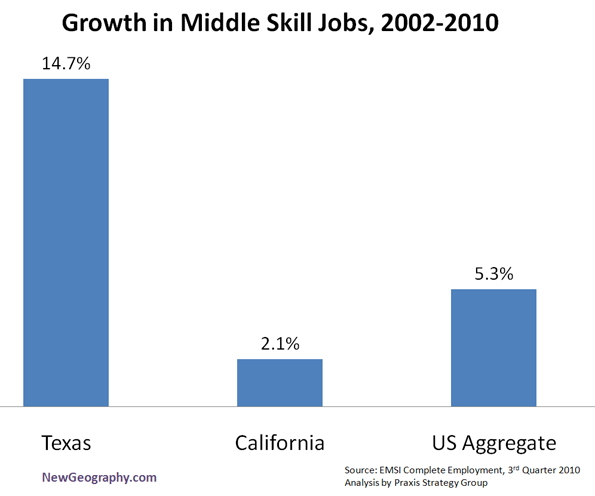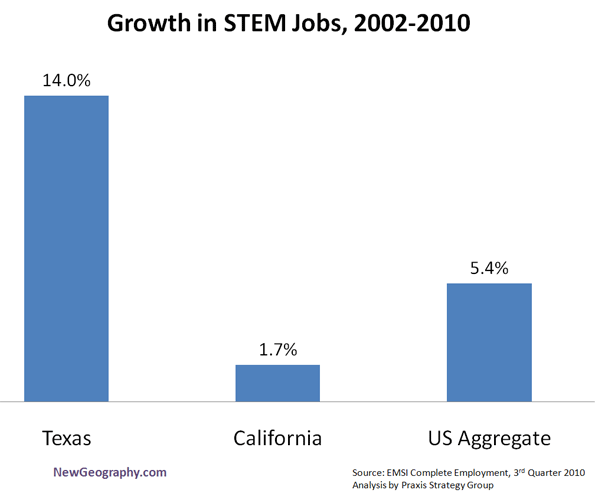
In the future, historians may likely mark the 2010 midterm elections as the end of the California era and the beginning of the Texas one. In one stunning stroke, amid a national conservative tide, California voters essentially ratified a political and regulatory regime that has left much of the state unemployed and many others looking for the exits.
California has drifted far away from the place that John Gunther described in 1946 as “the most spectacular and most diversified American state … so ripe, golden.” Instead of a role model, California has become a cautionary tale of mismanagement of what by all rights should be the country’s most prosperous big state. Its poverty rate is at least two points above the national average; its unemployment rate nearly three points above the national average. On Friday Gov. Arnold Schwarzenegger was forced yet again to call an emergency session in order to deal with the state’s enormous budget problems.
This state of crisis is likely to become the norm for the Golden State. In contrast to other hard-hit states like Pennsylvania, Ohio and Nevada, which all opted for pro-business, fiscally responsible candidates, California voters decisively handed virtually total power to a motley coalition of Democratic-machine politicians, public employee unions, green activists and rent-seeking special interests.
In the new year, the once and again Gov. Jerry Brown, who has some conservative fiscal instincts, will be hard-pressed to convince Democratic legislators who get much of their funding from public-sector unions to trim spending. Perhaps more troubling, Brown’s own extremism on climate change policy–backed by rent-seeking Silicon Valley investors with big bets on renewable fuels–virtually assures a further tightening of a regulatory regime that will slow an economic recovery in every industry from manufacturing and agriculture to home-building.
Texas’ trajectory, however, looks quite the opposite. California was recently ranked by Chief Executive magazine as having the worst business climate in the nation, while Texas’ was considered the best. Both Democrats and Republicans in the Lone State State generally embrace the gospel of economic growth and limited public sector expenditure. The defeated Democratic candidate for governor, the brainy former Houston Mayor Bill White, enjoyed robust business support and was widely considered more competent than the easily re-elected incumbent Rick Perry, who sometimes sounds more like a neo-Confederate crank than a serious leader.
To be sure, Texas has its problems: a growing budget deficit, the need to expand infrastructure to service its rapid population growth and the presence of a large contingent of undereducated and uninsured poor people. But even conceding these problems, the growing chasm between the two megastates is evident in the economic and demographic numbers. Over the past decade nearly 1.5 million more people left California than stayed; only New York State lost more. In contrast, Texas gained over 800,000 new migrants. In California, foreign immigration–the one bright spot in its demography–has slowed, while that to Texas has increased markedly over the decade.
A vast difference in economic performance is driving the demographic shifts. Since 1998, California’s economy has not produced a single new net job, notes economist John Husing. Public employment has swelled, but private jobs have declined. Critically, as Texas grew its middle-income jobs by 16%, one of the highest rates in the nation, California, at 2.1% growth, ranked near the bottom. In the year ending September, Texas accounted for roughly half of all the new jobs created in the country.
Even more revealing is California’s diminishing preeminence in high-tech and science-based (or STEM–Science, Technology, Engineering and Mathematics) jobs. Over the past decade California’s supposed bulwark grew a mere 2%–less than half the national rate. In contrast, Texas’ tech-related employment surged 14%. Since 2002 the Lone Star state added 80,000 STEM jobs; California, a mere 17,000.
Of course, California still possesses the nation’s largest concentrations of tech (Silicon Valley), entertainment (Hollywood) and trade (Port of Los Angeles-Long Beach). But these are all now declining. Silicon Valley’s Google era has produced lots of opportunities for investors and software mavens concentrated in affluent areas around Palo Alto, but virtually no new net jobs overall. Empty buildings and abandoned factories dot the Valley’s onetime industrial heartland around San Jose. Many of the Valley’s tech companies are expanding outside the state, largely to more business-friendly and affordable places like Salt Lake City, the Research Triangle region of North Carolina and Austin.
Hollywood too is shifting frames, with more and more film production going to Michigan, New Mexico, New York and other states. In 2002, 82% of all film production took place in California–now it’s down to roughly 30%. And plans by Los Angeles County, the epicenter of the film industry, to double permit fees for film, television and commercial productions certainly won’t help.
International trade, the third linchpin of the California economy, is also under assault. Tough environmental regulations and the anticipated widening in 2014 of the Panama Canal are emboldening competitors, particularly across the entire southern tier of the country, most notably in Houston. Mobile, Ala., Charleston, S.C., and Savannah, Ga., also have big plans to lure high-paid blue collar jobs away from California’s ports.
Most worrisome of all, these telltale signs palpable economic decline seem to escape most of the state’s top leaders. The newly minted Lieutenant Governor, San Francisco Mayor Gavin Newsom, insists “there’s nothing wrong with California” and claims other states “would love to have the problems of California.”
But it’s not only the flaky Newsom who is out of sync with reality. Jerry Brown, a far savvier politician, maintains “green jobs,” up to 500,000 of them, will turn the state around. Theoretically, these jobs might make up for losses created by ever stronger controls on traditional productive businesses like agriculture, warehousing and manufacturing. But its highly unlikely.
Construction will be particularly hard hit, since Brown also aims to force Californians, four-fifths of whom prefer single-family houses, into dense urban apartment districts. Over time, this approach will send home prices soaring and drive even more middle-class Californians to the exits.
Ultimately the “green jobs” strategy, effective as a campaign plank, represents a cruel delusion. Given the likely direction of the new GOP-dominated House of Representatives in Washington, massive federal subsidies for the solar and wind industries, as well as such boondoggles as high-speed rail, are likely to be scaled back significantly. Without subsidies, federal loans or draconian national regulations, many green-related ventures will cut as oppose to add jobs, as is already beginning to occur. The survivors, increasingly forced to compete on a market basis, will likely move to China, Arizona or even Texas, already the nation’s leader in wind energy production.
Tom Hayden, a ’60s radical turned environmental zealot, admits that given the current national climate the only way California can maintain Brown’s “green vision” will be to impose “some combination of rate heights and tax revenues.” Such an approach may help bail out green investors, but seems likely to drive even more businesses out of the state.
California’s decline is particularly tragic, as it is unnecessary and largely unforced. The state still possesses the basic assets–energy, fertile land, remarkable entrepreneurial talent–to restore its luster. But given its current political trajectory, you can count on Texans, and others, to keep picking up both the state’s jobs and skilled workers. If California wishes to commit economic suicide, Texas and other competitors will gladly lend them a knife.


This article originally appeared at Forbes.com.
Joel Kotkin is executive editor of NewGeography.com and is a distinguished presidential fellow in urban futures at Chapman University. He is author of The City: A Global History. His newest book is The Next Hundred Million: America in 2050
, released in February, 2010.
Photo by {Guerrilla Futures | Jason Tester}













California Vs. Texas
As a Texan, I reject the suggestion that California is somehow pitted against Texas in a fight for ... what? Which can be the most over-populated, polluted, unlivable? Our nation's urban areas generally have many more common traits and challenges than differences.
Come to Texas and we can show you the highest insurance rates in the nation, the highest real estate taxes, congested freeways, growing water shortages, unacceptable levels of air pollution. Looking for empty buildings? We have those, too.
But hold the despair. We have much to be happy about, including the positive impact of the best-regulated banks in the nation. The outer suburbs of cities such as Dallas are seeing significant urban-style development chasing light rail (yes -- light rail!) that is springing up across the region. We're moving to wind, geothermal and solar for our schools and other public buildings in every major city in this state.
People don't talk about that much because it doesn't fit the lazy Red State-Blue State crutch that is invariably employed as a way of explaining why this state or that seems to be doing better or worse than another.
The reality is that every state in America needs to be doing better but we just can't click our heels and be back in some earlier-time Nirvana that never really existed in the first place.
Californians are making huge contributions to solving the mess that all of America has become. And we in Texas intend to be right there with them helping to making it happen.
-- Tom Kessler
Flower Mound, Texas
Silicon Valley Job Listings Up 67% Year-over-Year
"more business-friendly and affordable places like Salt Lake City, the Research Triangle region of North Carolina and Austin"
and between all those regions, just 1 NASDAQ 100 HQ - Dell, and the only tech company of note based in either RTP or Salt Lake is Red Hat, which did $748 million of revenue last year, or about 1/30th of what Oracle did
I don't know where the "STEM" data comes from, but I'll bet most of that is workers implementing technology, not creating it. If you want to see a lot of that, come here to the DC area, where we have armies of network engineers, database admins, and "project managers" spending your tax dollars implementing products created in California.
California Has 33 Tech Companies in the NASDAQ 100, Texas has 2
Agree completely that California state government is a mismanaged disaster owned by public unions. But there's more to an economy than teacher union lobbyists and the Dem AND GOP pols they've bought.
I recently did an analysis of corporate HQ locations for NASDAQ 100 companies, and identified 62 of the 100 companies as technology suppliers of some kind. The non-tech included a lot of retailers like Bed, Bath & Beyond and Costco. In any event, of the 62, 33 were based in California, and just 2 - Dell and BMC Software - in Texas. My business-friendly home state of Virginia had just 1, the holding company spun out of the Sprint/Nextel merger.
California, particularly the Bay Area, will be fine regardless of what silly, feel-good initiatives Jerry Brown wastes money on. There is a big difference between developing an economy for everyone, which Texas has done successfully, and developing a technology economy, which has nothing to do with state government.
California's Woes
I thank my stars every single day for having had the foresight to bail out of California before the economic tsunami hits. Colorado has proven to be far more business friendly and optimistic in its outlook.
My prediction is that we are almost certain to see a "Fiscal Brown Out"...i.e. state insolvency" in California during Gov Brown's term. His pro union proclivities will serve as the final death knell in sinking the ship.
And I often ponder what would have occurred if Meg Whitman had invested her $142 million into jump-starting the Calif economy versus trying to win the governors race? This would have been a far more effective use of her money vis-a-vis chasing the thankless governorship.
Michael Scott
Urban Engagement WebCity
http://urbanengagement.wordpress.com
Give Jerry A Chance
Let’s see what Jerry Brown comes up with. He is, after all, one of our most nimble politicians. His economic development approach yielded some tangible results in hard-pressed Oakland. And give California voters some credit for rejecting Meg Whitman, whose big bucks could not make up for her lack of imagination and appeal.
give jerry a chance?
Oakland is a decaying mess. People are fleeing it's best neighborhoods and it's worst are crime infested rat holes. Other than starting a small Military charter, Brown failed at improving the schools, failed at improving the business climate, and failed at lowering crime. His only success was getting empty condos built downtown during the real estate bubble. Only the feckless indifference of his successor makes him look good in comparison. Jerry is a creature of the public employee unions who have driven the state into bankruptcy. If he continues the "climate-change" policies of Ahnold the cartoon character, these will look like the good old days.